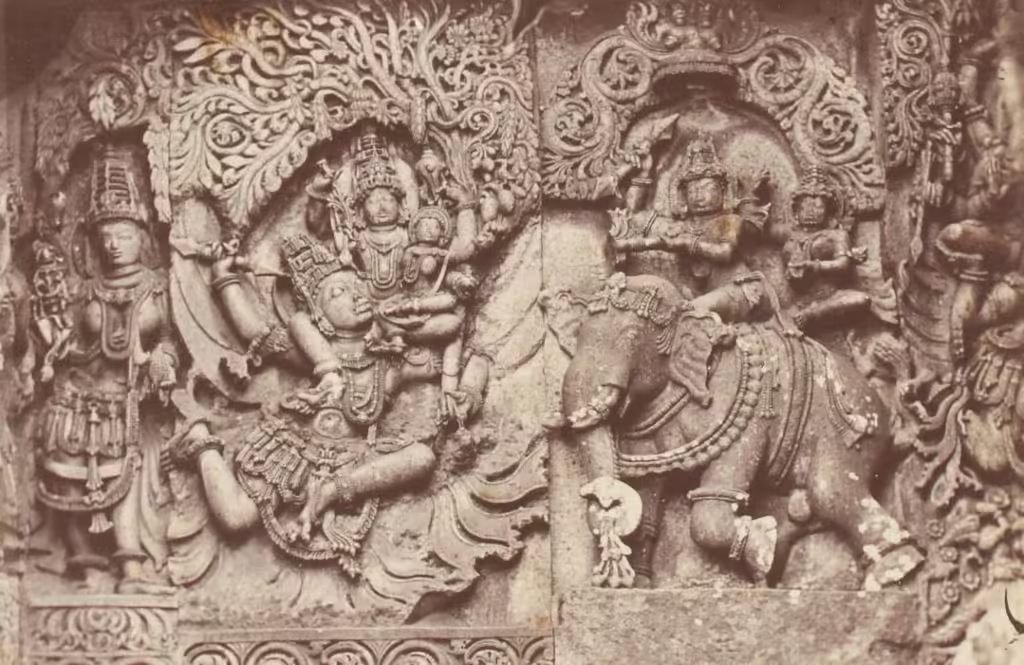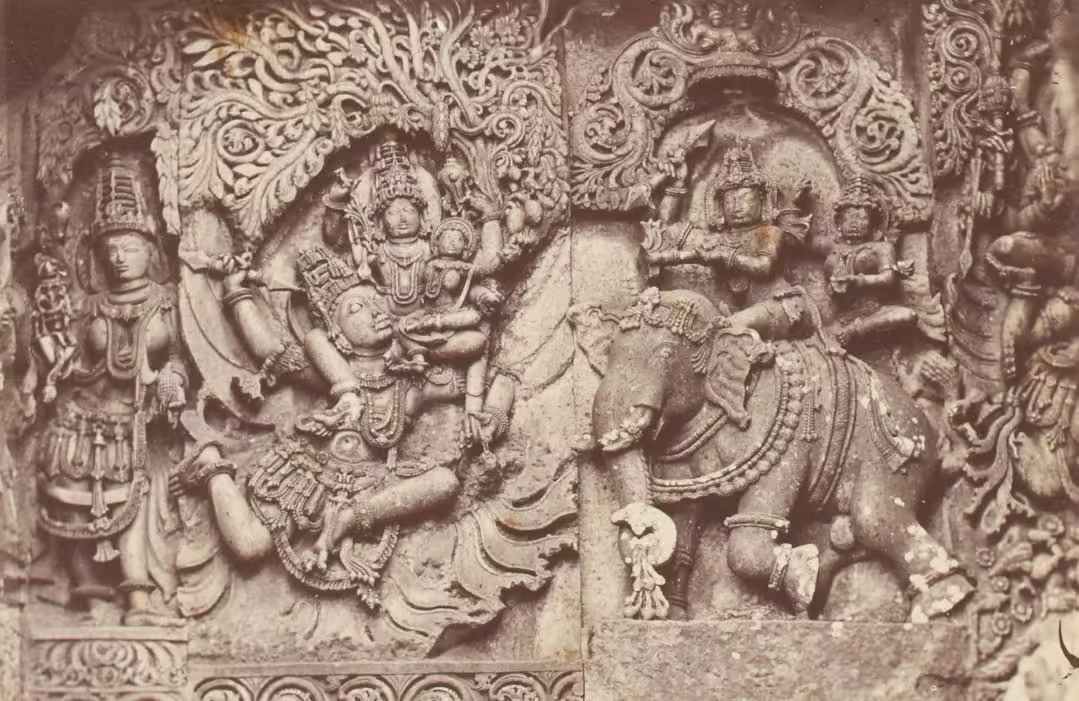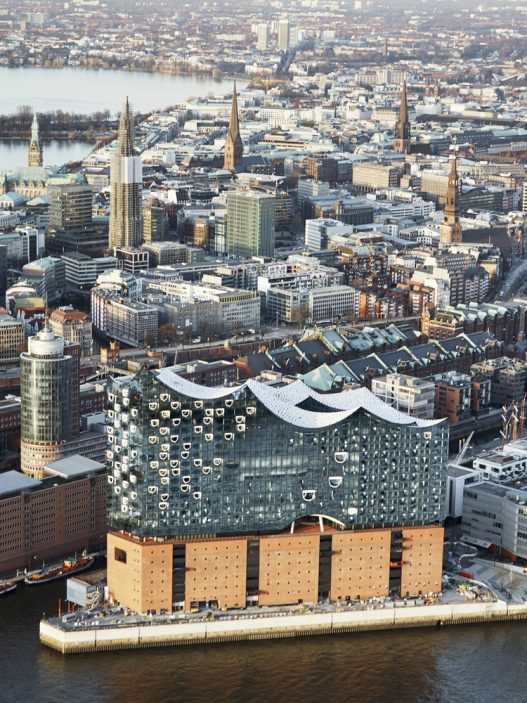Traditional Indian architecture is a vibrant tapestry woven with cultural, religious and artistic influences over centuries. It reflects the diverse history of the Indian subcontinent and showcases a variety of styles that vary from region to region. This architecture serves not only as a shelter but also as a canvas for art, spirituality and community life. By exploring its historical context, key features, cultural significance, evolution over time and intricate carvings, we can appreciate the depth and richness of this architectural heritage.

Historical Context
The roots of traditional Indian architecture can be traced back to the Indus Valley Civilization, which first developed urban planning and advanced drainage systems. Over the millennia, various dynasties and empires, including the Mauryas, Guptas, Cholas and Mughals, contributed to the architectural landscape, each leaving its own mark. The infusion of Hindu and Buddhist influences into Islamic architecture during the medieval period led to a melting pot of styles. For example, the magnificent temples of South India contrast sharply with the elaborate mosques of the North, demonstrating regional diversity and the evolution of architectural practices influenced by changing religious beliefs and cultural exchanges.
Key Features
Traditional Indian architecture is characterized by the use of local materials, intricate designs, and a strong connection to nature. Buildings often have large open spaces and courtyards that facilitate air circulation and social interaction. Roof designs vary considerably, from flat roofs seen in arid regions to sloping roofs in regions with high rainfall. The use of ornamentation is a hallmark of this architecture, including elaborate carvings, jali (lattice) work, and vivid frescoes. These elements not only serve aesthetic purposes, but also reflect the craftsmanship and artistic sensibilities of the period.
Cultural Significance
In India, architecture is deeply intertwined with cultural and spiritual life. Temples, for example, are not simply places of worship but embody cosmic order and the relationship between the divine and the mundane. The layout of these structures often follows sacred geometry, aiming to evoke harmony and balance. Similarly, forts and palaces represent the power and prestige of ruling dynasties and often serve as centers for administrative and cultural activities. Festivals and rituals are intricately linked to these spaces, reinforcing their importance in the daily lives of communities.
Evolution Through Time
Over the centuries, traditional Indian architecture has evolved to adapt to new materials, technologies, and cultural influences. The colonial period brought in Western architectural styles, resulting in a fusion seen in many modern buildings today. However, there is a revival of interest in traditional methods and designs in contemporary architecture, as architects seek to blend modern needs with historical sensibilities. This evolution is evident in new structures that honor traditional aesthetics while incorporating sustainable practices that reflect a growing awareness of environmental concerns.
Carvings Overview
Carvings are one of the most important elements of traditional Indian architecture, serving both decorative and narrative purposes. They often depict mythological stories, religious symbols, and natural motifs, providing insight into the socio-cultural context of the period. Intricate stone carvings adorn temples, palaces, and public buildings, and showcase the skills of craftsmen who have dedicated their lives to this craft. The elaborate sculptures of Khajuraho and the ornate pillars of Hampi are notable examples where each carving tells a story or symbolizes a deeper meaning. These works not only enhance the visual appeal of the structures, but also invite viewers to reflect on their significance by connecting them to India’s cultural heritage.
As a result, traditional Indian architecture is a living expression of the country’s rich history and diverse cultures. Its historical context, key features, cultural significance, evolution and exquisite carvings reflect a deep understanding of space, art and society. By appreciating this architectural heritage, we can gain deeper insight into how buildings shape the lives of their occupants and how they are shaped by them.
Types of Carving in Indian Architecture
Indian architecture is a rich tapestry woven with various artistic expressions, one of which is carving. Carvings play a vital role in enhancing the aesthetic appeal and cultural significance of structures across the subcontinent. They embody the stories, myths and spiritual essence of the regions they represent. This exploration examines the different types of carvings found in Indian architecture, revealing their unique characteristics, historical significance and real-world applications.
Stone Carvings
Stone carvings are perhaps the most enduring and iconic form of artistic expression in Indian architecture. Dating back thousands of years, they often adorn temples, monuments and palaces. The intricate designs reflect not only the skill of the craftsmen but also the religious and cultural narratives of the period.
One of the most famous examples is the rock-cut temples of Ellora and Ajanta in Maharashtra. These temples have stunning sculptures depicting various deities, celestial beings and intricate floral patterns. The durability of the stone ensures that these carvings will stand the test of time and future generations will be able to appreciate the craftsmanship.
In contemporary architecture, stone carving continues to be relevant with modern buildings incorporating traditional motifs to maintain a connection with heritage. This blend of old and new is a testament to the timeless nature of stone as a medium.
Wood Carvings
Wood carvings in Indian architecture are deeply rooted in local traditions and craftsmanship. They often adorn doors, windows, and ceilings, displaying intricate art that reflects the culture of the region. The use of wood allows for elaborate and delicate designs, such as those seen in the wooden temples of Kerala, where the art tells stories of mythology and local traditions.
The famous temples of Khajuraho, though predominantly in stone, also display exquisite wood carvings. The carvings often depict scenes from daily life, nature and religious iconography, offering a glimpse into the socio-cultural fabric of the period.
In modern times, wood carving is not limited to traditional architecture. Many contemporary designers are re-applying wood carving techniques to furniture and interior design, blending traditional skills with modern aesthetics and creating spaces that reflect history while appealing to current tastes.
Terracotta Carvings
Terracotta, a clay-based material, has been used in Indian architecture since ancient times. Its versatility and ease of manipulation make it an ideal medium for decorative elements. Terracotta carvings often depict figures, animals, and motifs representing local culture and traditions.
The terracotta temples of West Bengal are a notable example, where intricate reliefs and sculptures tell stories from folklore and mythology. These carvings serve not only aesthetic purposes but also serve as a form of documentation of the region's history and beliefs.
In contemporary architecture, terracotta is being used in innovative ways from façades to landscape elements, adding rustic charm while promoting sustainability. The resurgence of terracotta in modern design highlights its enduring appeal and relevance.
Metal Engravings
Metal carvings, especially made of bronze and copper, hold an important place in Indian architecture. Often associated with religious artifacts, these carvings are commonly found in temples, where they depict deities and mythological stories. The intricate details and polished surfaces of metal sculptures add a sense of grandeur and reverence to sacred spaces.
The famous bronze idols of South Indian temples are the best examples of this art form. The craftsmanship used in making these idols is exquisite, reflecting the spiritual significance they hold in rituals and worship.
Today, metal carvings are also seen in contemporary public art installations and architecture, where artists combine traditional techniques with modern designs. This fusion not only preserves the art form, but also ensures its continuity by introducing it to new audiences.
Plaster Carvings
Stucco carvings, often seen in Mughal architecture, are a testament to the fusion of art and architecture. This technique allows for intricate designs that can cover large surfaces, from wall panels to ceilings. The use of plaster allows artists to create elaborate patterns and motifs that reflect the cultural and aesthetic values of the time.
One of the finest examples of stucco carvings can be found in Humayun's tomb in Delhi, where delicate floral and geometric patterns enhance the beauty of the structure. These carvings often symbolize the connection between the mundane and the divine, making them important both artistically and spiritually.
Plaster carving is making a resurgence in modern architecture, particularly in restoration projects and new construction that aims to evoke historical elegance. By blending traditional techniques with contemporary design, architects are creating spaces that honor the past while embracing the future.
As a result, the various types of carvings in Indian architecture not only enhance the visual appeal of structures, but also tell stories that are deeply rooted in the culture and history of the region. From the enduring elegance of stone to the intricate beauty of metal and the warmth of wood, each type of carving contributes to a diverse architectural heritage that continues to inspire and evolve.
Symbolism and Themes in Carvings
Carvings have been an important form of expression across cultures and eras, transforming raw materials into complex storytelling tools. These artistic expressions often carry deep meaning and reflect the beliefs, values and stories of the societies that created them. From religious significance to natural motifs, carvings encompass complex themes that resonate through time, inviting us to explore their rich symbolism.
Religious Symbols
Religious symbols in carvings serve as powerful conduits of faith and spirituality. Craftsmen across cultures have depicted divine figures, sacred texts, and ritualistic symbols, each of which holds deep significance. For example, in Christian art, the cross is often seen in ornate stone reliefs symbolizing sacrifice and salvation. Similarly, intricate carvings of deities such as Vishnu and Shiva in Hindu temples depict tales of their divine exploits, serving both as a form of worship and a means of educating devotees.
These religious carvings not only enhance the aesthetics of sacred spaces, but also serve as visual narratives that convey moral lessons, spiritual ideals, and the essence of the divine. In many cultures, the act of carving itself is considered sacred, as it connects the artisan to the divine and makes each piece a unique expression of faith.
Nature and Wildlife
Nature and wildlife are recurring themes in carvings that reflect humanity’s deep connection to the natural world. Since ancient times, artists have depicted animals, plants, and landscapes, often imbuing their work with symbolic meaning. For example, in many indigenous cultures, animals are viewed as totems or spirit guides, and their representation in carvings can imply protection, wisdom, or strength. The intricate details of a carving showing an eagle in flight or a bear at rest can evoke the beauty and power of these creatures and remind us of the balance between humans and nature.
Additionally, carvings inspired by nature can reflect the rhythms of the seasons, representing the cycles of life, death, and rebirth. For example, in Japanese art, cherry blossoms often symbolize the fleeting beauty of life, encouraging viewers to appreciate fleeting moments. These carvings not only celebrate the beauty of the natural world, but also invite reflection on humanity’s relationship with it.
Mythological Narratives
Mythology is rich with tales that have captivated the human imagination for centuries, and carvings often serve as a vehicle to bring these stories to life. From the great epics of ancient Greece to the intricate tales of Native American folklore, carvings can depict gods, heroes, and mythical creatures, each telling a story that reflects the values and morals of the culture. For example, the intricate carvings on the Parthenon in Athens depict the myths surrounding Athena, showcasing her wisdom and power.
These mythological narratives are not merely decorative; they are crucial to preserving cultural heritage and identity. By carving these stories into stone or wood, artisans enable future generations to connect with their past and understand the lessons and themes that shape their world. Each carving becomes a window into a rich tapestry of human experience, allowing us to explore universal themes such as conflict, love, and the search for meaning.
Social and Cultural Themes
Carvings often reflect the social and cultural dynamics of the societies that created them. They can depict daily life, social hierarchies, and cultural rituals, and serve as historical documents that reveal much about a community's values and norms. For example, in many African cultures, carvings can depict social gatherings, ceremonies, or the roles of different individuals in society, providing insight into social structure and cultural practices.
Additionally, carvings can be a form of resistance or commentary that reflects the struggles and aspirations of a people. For example, works by contemporary Indigenous artists often incorporate traditional motifs while addressing current social issues, blending past and present to create a dialogue that challenges viewers to rethink their perceptions of history and identity. Through these carvings, artists convey powerful messages, making art a vital part of public discourse.
Geometric Patterns
Geometric patterns in carvings are often celebrated for their aesthetic beauty and mathematical precision. These designs can be found in a variety of cultures, from Islamic art to indigenous motifs, each carrying its own meaning and interpretation. In many cases, geometric patterns symbolize harmony, balance, and the infinite nature of the universe. For example, the intricate, repetitive designs found in Islamic architecture serve not only a decorative purpose, but also reflect beliefs in the unity and order of creation.
These patterns can also serve practical purposes, guiding the eye and creating a sense of movement in the artwork. In indigenous cultures, geometric patterns often represent natural elements and can be seen as a way to connect the viewer to the earth and its cycles. By engaging with these patterns, viewers are invited to consider the deeper connections between art, mathematics, and the world around them.
As a result, the symbolism and themes found in the carvings present a rich tapestry of human expression. They encompass beliefs, narratives and social dynamics, and invite us to explore the deep connections between art and culture. Each carving tells a story, bridging the gap between past and present, and allowing us to connect with universal themes that define our shared human experience.
Noteworthy Examples of Carving
Carvings in architecture display not only aesthetic value, but also historical and spiritual significance, as evidence of a culture’s artistic talents. Across the world, structures feature intricate carvings that tell stories, depict religious themes, and celebrate the human experience. In this research, we examine some of the most important examples of carvings found in temples and palaces, highlighting their beauty and cultural significance.
Khajuraho Temples
The Khajuraho Temples in Madhya Pradesh, India, are famous for their striking sculptures and intricate carvings dating back to the 10th and 11th centuries. Built during the Chandela Dynasty, these temples were initially dedicated to Hindu deities, but later incorporated Jainism. The carvings cover a wide range of subjects, from divine figures to everyday life, including musicians, dancers, and even playful animals.
One of the most striking features is the depiction of erotic sculptures, which, rather than being purely provocative, are believed to symbolize the celebration of love and the interconnectedness of the spiritual and physical realms. These carvings are not only artistically impressive, but also serve as a window into the social norms and cultural values of the period. The Khajuraho Temples, a UNESCO World Heritage Site, attract visitors who are captivated by their beauty and the stories they tell.
Vittala Temple of Hampi
Hampi, a UNESCO World Heritage Site in Karnataka, India, is famous for its ancient ruins and the Vittala Temple, which exemplifies the grandeur of Vijayanagara architecture. The temple is particularly known for its striking stone chariot and musical pillars, each carved from a single piece of stone.
The carvings at the Vittala Temple are intricate and detailed, depicting various deities, floral patterns, and mythological scenes. Each pillar was designed to produce musical notes when struck, a testament to the architectural ingenuity of the period. The temple complex reflects not only religious devotion but also the artistry and craftsmanship of the artisans who worked on it. Visitors to Hampi often find themselves mesmerized by the harmonious blend of architecture and sound created by these carvings.
Jaipur City Palace
Located in the heart of Jaipur, the City Palace stands as a symbol of the city’s royal heritage and displays stunning artistry with its detailed carvings. A blend of Rajasthani and Mughal architecture, the palace was built from the 18th century onwards and features intricate marble and stonework adorning its walls and ceilings.
The carvings in the City Palace often depict scenes from royal life, as well as natural motifs including birds and flowers. The attention to detail is astonishing and reveals the skill of the craftsmen who meticulously carved each design. The palace serves not only as a historical monument, but also as a museum that offers visitors a glimpse into the opulent lifestyle of the Rajput kings. The vibrant colors and exquisite carvings take one back in time, revealing the rich cultural fabric of Jaipur.
Meenakshi Temple, Madurai
The Meenakshi Temple in Madurai is an architectural marvel known for its towering gopurams (gateway towers) adorned with thousands of colorful and intricate carvings. Dedicated to Goddess Meenakshi, the temple dates back to the 7th century and has been expanded over the centuries to create a breathtaking display of Dravidian architecture.
Depicting various deities, mythological stories, and vivid scenes from Hindu epics, the carvings are painted in vibrant colors that enhance their beauty. Each figure is crafted with an incredible level of detail that invites viewers to explore the stories behind them. The temple serves not only as a place of worship but also as a cultural center that hosts numerous festivals that attract both devotees and tourists. The vibrant carvings of the Meenakshi Temple are a celebration of faith, art, and community.
Sun Temple, Konark
The Sun Temple in Konark, Odisha is a stunning example of Kalinga architecture, built in the 13th century to honor the sun god Surya. The temple was designed to resemble a massive chariot, with twelve pairs of intricately carved stone wheels symbolizing the passage of time and the movement of the sun.
The carvings on the temple walls are extraordinary, depicting a range of subjects from celestial beings to intricate floral patterns. The artistry and craftsmanship used in creating these detailed sculptures reflects the high level of skill of the craftsmen of the period. The Sun Temple is not only an architectural marvel, but also a narrative of the cosmos and the rhythms of life, making it a profound cultural landmark. Visitors are often left in awe of the temple's grandeur and the stories contained in its carvings.
In summary, these significant examples of architectural carvings highlight the diverse cultural expressions and historical narratives found in different regions. Each area tells its own story through art, inviting us to explore and appreciate the creativity that shapes our built environment.
Techniques and Tools Used in Carving
Carving is a timeless art form that has been practiced across cultures for centuries. It involves shaping materials such as stone, wood, and even synthetics to create intricate designs or functional objects. The techniques and tools used in carving have evolved to reflect advances in technology and changes in artistic expression. This section examines the various methods and tools used in carving, from traditional practices to modern adaptations.
Traditional Vehicles
Traditional carving tools have roots in the earliest human civilizations. These tools, usually handmade, were indispensable to artists and craftsmen. Chisels, hammers, and rasps were common for stone carving. Typically made of steel, chisels came in a variety of shapes and sizes, allowing craftsmen to achieve different textures and details. Hammers, usually made of wood or metal, were used to strike the chisels and drive them into the stone.
Blades and gouges are essential to woodcarving. A carving knife is usually thin and flat, perfect for outlining shapes, while gouges have curved blades that allow for deeper cuts and more intricate designs. Mastering these tools requires skill and practice. The tactile feedback provided by the materials helps carvers develop a deep connection to their craft. Traditional tools emphasize craftsmanship, where each piece is unique and shaped by the hands of the craftsman.
Stone Carving Techniques
Stone carving is a meticulous process that involves a variety of techniques, each yielding different effects and finishes. One common method is direct carving, where the artist works directly onto the stone, removing material until the desired form is created. This method allows for spontaneity and personal expression, as the artist can respond to the natural qualities of the stone.
Another technique is relief carving, where the design is raised above the background plane. This technique is often used in architectural elements and decorative pieces. The carver must carefully plan how deep to cut to achieve the desired effect, balancing depth and detail.
Additionally, the use of point chisels, flat chisels, and other specialized tools allows artists to create different textures and finishes on the surface of the stone. For example, a burr can create a rough texture, while a polishing tool can give a smooth, reflective surface. Each technique requires not only skill, but also an understanding of the properties of the material.
Wood Carving Methods
Like stone carving, wood carving encompasses a variety of techniques and styles. One popular method is chip carving, where small pieces of wood are removed to create geometric patterns or intricate designs. This technique is particularly popular for its accessibility, as it requires minimal tools and can be done on small pieces of wood.
Another method is sculpting, which involves carving shapes and figures from a single piece of wood using a knife. Sculpting is often seen as a meditative practice, allowing the artist to focus on the form and flow of the wood. It requires patience and an understanding of the wood's grain, as different types of wood behave differently under the knife.
In contrast, wood carving involves creating designs that stand out from the background, similar to stone carving. This method is often used in furniture making and decorative arts. Each technique in wood carving not only showcases the artist's skill, but also celebrates the wood's unique qualities, such as color and grain patterns.
Protection Techniques
Preservation is a very important aspect of carving, especially for historical and cultural artifacts. Whether made of stone or wood, carvings are susceptible to damage from environmental factors such as humidity, temperature fluctuations and pollution. Various preservation techniques are used to reduce these risks.
Regular cleaning and application of protective coatings for stone carvings can increase durability. These coatings seal the stone, preventing water infiltration and reducing the risk of erosion. Additionally, climate-controlled environments are often used to store valuable pieces, maintaining constant humidity and temperature levels to prevent cracking or warping.
Wood carvings require similar care. They should be kept in areas with controlled humidity to prevent them from drying out or becoming too humid, which can lead to warping or fungus. Using beeswax or special wood polishes can provide a protective layer, enhancing the wood’s natural beauty while protecting it from damage. Conservationists often work closely with artists to ensure that both the integrity and artistry of the carvings are preserved for future generations.
Modern Adaptations
In recent years, engraving has made significant advances thanks to technology. Computer Numerical Control (CNC) machines and laser cutters have revolutionized the way artists and manufacturers approach engraving. These machines can produce intricate designs with precision and speed, allowing for mass production while still maintaining an artistic sense.
Digital tools have also allowed artists to experiment with new forms and styles. Software programs allow for 3D modeling, allowing carvers to visualize their designs before they begin actual work. This blend of traditional craftsmanship and modern technology has opened up new avenues for creativity, making carving more accessible to a wider audience.
Despite these developments, many artisans continue to value and practice traditional methods. The tactile nature of hand carving offers a unique connection to the material that machines cannot replicate. This juxtaposition of old and new reflects the dynamic nature of the art form, where tradition and innovation can inspire each other, creating a vibrant and evolving landscape in the world of carving.
Through these different techniques and tools, carving continues to be a powerful form of expression that connects the past to the present while continually shaping the future of this ancient art.
The Future of Carvings in Indian Architecture
The intricate art of carving has been a cornerstone of Indian architecture for centuries, showcasing cultural narratives, religious beliefs and regional identities through stunning craftsmanship. Looking ahead, the evolution of carving techniques and their integration into contemporary architecture presents both exciting opportunities and significant challenges. This research will explore contemporary trends, modern design integration, hurdles faced by traditional methods, revival efforts and the impact of technology on this ancient art form.
Contemporary Trends
In recent years, there has been a resurgence of interest in traditional carving techniques among architects and designers. Contemporary trends often blend historical styles with modern aesthetics, creating a dialogue between the past and present. Artists are experimenting with new materials, such as composite stones and eco-friendly alternatives, that allow for more sustainable yet intricate designs. This modern approach not only preserves the essence of traditional carvings, but also makes them accessible to a wider audience.
Moreover, there is a growing appreciation for regional carving styles that reflect India’s diverse cultural heritage. For example, the elaborate jali work of Rajasthan is being incorporated into urban spaces to create unique identity markers on modern buildings. This trend highlights a shift towards architects celebrating local craftsmanship, collaborating with traditional artisans to create pieces that resonate with both history and contemporary life.
Integration with Modern Design
The integration of carvings into modern design represents a fascinating fusion of old and new. Today, architects are not just imitating traditional motifs; they are reinterpreting them to suit contemporary contexts. For example, carved facades are used on high-rise buildings to provide shade and reduce energy consumption, while adding an aesthetic layer that recalls the rich traditions of Indian architecture.
This integration involves using advanced computer-aided design technologies to create intricate patterns that are often difficult to achieve by hand. Such collaborations between artisans and technologists pave the way for innovative designs that honor traditional techniques while embracing the efficiency of modern tools. This blend of craftsmanship and technology can be seen in public spaces where carved elements are used not only for decoration but also for functional purposes, enhancing both beauty and utility.
Challenges Facing Traditional Techniques
Despite the revival of interest in carving, traditional techniques face a number of challenges. One of the most pressing issues is the dwindling number of skilled craftsmen in these ancient methods. As younger generations move away from traditional crafts in favor of more lucrative careers, they risk losing invaluable knowledge and skills. This generation gap poses a significant threat to the authenticity and continuity of carving practices.
In addition, the rapid pace of urbanization and the demand for fast, cost-effective building solutions often prioritizes efficiency over craftsmanship. This shift has led to the decline of intricate carving in favor of simpler, mass-produced alternatives that lack the spirit and story of craftsmanship. Striking a balance between the need for modern architecture and the preservation of traditional skills is a challenge that requires careful consideration from all stakeholders.
Revitalization Efforts
In response to these challenges, various initiatives are underway to revive the art of carving in Indian architecture. Community workshops and training programs aim to ensure that knowledge of carving techniques is not lost by imparting traditional skills to young artisans. These programs often emphasize the cultural significance of the craft, inspiring new generations to engage with their heritage.
Additionally, collaborations between architects and craftsmen are increasingly common, encouraging a renewed appreciation of craftsmanship. These partnerships help bridge the gap between old and new by showcasing the beauty and importance of traditional carvings in modern projects. Exhibitions and cultural festivals celebrating traditional crafts also play an important role in raising awareness and stimulating interest in the art of carving.
The Role of Technology
Technology is playing an increasingly important role in the future of carving in Indian architecture. Advanced tools like laser cutters and CNC machines are enabling precise and intricate designs that preserve the essence of traditional craftsmanship while increasing efficiency. These technologies are pushing the boundaries of what is possible in carving by allowing artisans to experiment with new forms and styles.
Moreover, digital platforms provide greater visibility for traditional artisans, allowing them to showcase their work to a global audience. This visibility not only opens up new markets, but also fosters a dialogue about the importance of preserving cultural heritage in the face of modernization. The combination of technology and traditional carving techniques holds great promise, potentially leading to a renaissance in this ancient art form.
In conclusion, the future of carvings in Indian architecture is a tapestry woven of tradition and innovation. As contemporary trends emerge and technology advances, the challenge of preserving the essence of this rich art form while embracing new methodologies becomes evident. Through revival efforts and collaboration, there is hope for a vibrant future where the beauty of carvings continues to inspire and connect generations.
Discover more from Dök Architecture
Subscribe to get the latest posts sent to your email.




















